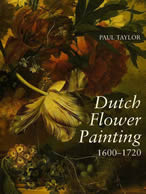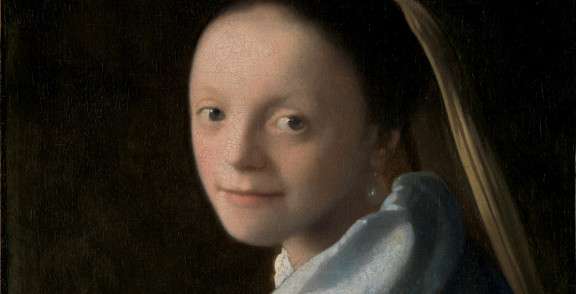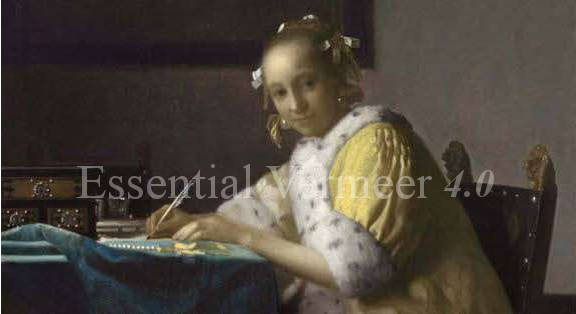Since the beginning of the twentieth century, Vermeer's art has been championed as an example of the "art for art's sake" doctrine which held that art was valuable as art and did not require any sort external justification. Art was no longer judged for its moral, didactic or political message but for its formal values. From then on, art was largely discussed in terms of style color, line, shape, space and composition. Although in the last half of the century art historians have correctly realigned Vermeer's art within the context of his times authoritative Vermeer experts have continued to eulogize the uncanny formal compositional arrangements of his quiet interior scenes. In their discussions, one of the terms most frequently associated with the artist's compositions is, no doubt, "balance."
Paul Taylor, who has extensively investigated seventeenth-century European and Dutch art theory, has taken a fresh look at the question of Vermeer's composition marshaling convincing evidence that we may have to rethink some of our unquestioned assumptions about how Vermeer went about arranging his pictorial designs.
June 4, 2010
The Essential Vermeer: In a recent paper, you argued that the concept of aesthetic balance may not have been available to Vermeer and that his pictures were more likely composed according to different standards. Can you tell us something about how composition was conceived in seventeenth-century Holland?
Paul Taylor: In my paper I argued that there is no evidence, from contemporary writings on art, that the concept of 'compositional balance' existed in the Dutch language in Vermeer's day. It is of course possible that the concept was used in the studios, but never found its way into the art theoretical writings, which are after all not so very abundant. However I backed up my assertion with a stronger claim, that the concept is not found in any European writings on art before the nineteenth century. This is a more speculative statement, and I shall happily withdraw it if someone can come up with an earlier example; but to date no one has refuted my conjecture.
I also argued that it is very difficult to use the paintings themselves as evidence in this debate, and devoted some time to a skeptical discussion of recent analyses of the Metropolitan Woman with a Balance, which is widely thought to be one of his most carefully composed paintings.
As for how composition was conceived in the Netherlands in the seventeenth century: two writers on art, Karel van Mander and Gérard de Lairesse, discuss the subject at length. It is not easy to summarise their thoughts on the matter in a few lines, but both are concerned with how to tell stories clearly in a painting. Of the two, Van Mander is the more 'aesthetic', in that he has ideas on how to make a composition look pleasing—for example, adding a view off into a distant landscape. His thoughts on all this are of interest, but he does not talk about 'balance'. Lairesse is more concerned with probability, 'waarschynelykheid', and believes that a composition is largely a matter of thinking through the logic of a situation, the events taking place, the disposition of the figures, their relationship to the light source, and so forth, in a clear and consistent way.
What evidence of these compositional norms do you find specifically in Vermeer's painting? Can you give us a good example in a specific painting?
I'm a bit hesitant about calling them 'norms' when we have just two main sources, and they have rather different attitudes to the subject of composition, but I think that some of the concerns of Van Mander and Lairesse are reflected in contemporary paintings. For example, Lairesse has a number of simple, practical points to make concerning the fall of light and how it forces the painter to group figures in particular dispositions, so they can clearly be seen. In a number of Vermeer's paintings the figures are grouped round a window so that they will be lit clearly, even if it makes the narrative more awkward. The exception that proves the rule is the Officer with a Laughing Girl in the Frick, where the officer in question sits with his back to us, almost entirely in shadow. The arrangement is very lifelike, in that this figure is directly across the table from the laughing girl to whom he is talking, but we can hardly see him. Lairesse would not have approved of such a composition, I think, and it may be that Vermeer too decided that it was unsatisfactory, since he never did it again.
How did you come upon the idea?
While re-reading Lairesse.
In essence, are you saying that Vermeer organized the design of his compositions according to the literal or symbolic meaning of the objects he represented rather than the abstract or aesthetic qualities that they assume when transformed into paint on the flat surface of his canvas, which is, after all, the sin qua non of pictorial representation?
I'm suggesting that the seventeenth-century evidence would seem to make that conclusion plausible, but I'm aware that the evidence in question isn't entirely decisive.
If your hypothesis is correct, why in your opinion have specialist writers so insistently utilized the concept of aesthetic balance to describe Vermeer's work?
The artistic ideas of the nineteenth and early twentieth century still have a considerable impact on the ways that art historians think about paintings, and about composition in particular. There can't be many more famous statements about art than Maurice Denis's dictum, 'Remember that a picture, before being a battle horse, a nude, or some anecdote, is essentially a flat surface covered with colours assembled in a certain order'. Many of us were brought up to look at pictures in this way, and it can be very hard to unlearn the way you were taught to approach art in the first place.
In addition—I'm happy to agree with this—many of Vermeer's paintings do strike the eye as unusually balanced and harmonious, especially when compared to work by other artists of the period, like Rembrandt or Pieter de Hooch. The question, however, is whether this is something Vermeer actively intended, or whether it is an accidental consequence of different interests, such as a desire to use an accurate perspective construction, or to tell a story as clearly as he could.
It could be said that the act of balancing pervades, (consciously and/or unconsciously) daily life today as it most probably did the lives of seventeenth-century Dutchmen. Carts full of merchandise had to be balanced lest they tip over and ships had to be balanced so that they would sail upright. One of Vermeer's women is portrayed balancing her scales to verify the worth of her coins. However, aesthetic balance may have also played a part in the art of daily living. A cook had to "balance" the ingredients of her bread pudding to make it tastier and the housewife had to "balance" the disposition of her pretty pieces of imported Kraakporselein on the wall racks. It is hard to believe that she would have haphazardly cramped her family's paintings on one wall while the other wall was left blank with no concern for an overall aesthetic disposition. Even though the concept of balance may not been codified in art writings, do you believe that Vermeer could have been immune to such a natural predisposition as he arranged visual objects in his compositions?
It would be interesting to make a study of all the words connoting 'balance' in seventeenth-century Dutch, to see how wide a semantic field they covered. The central meaning of course is 'equilibrium', as of a pair of scales, and the other, derived senses are more or less metaphorical. We are so used to talking about 'balanced compositions' that we have perhaps forgotten that it is just a metaphorical extension of the principal meaning, and not perhaps an immediately obvious one. The concept of 'balance' has probably grown since Vermeer's time, as new areas of metaphorical meaning have, so to speak, been discovered. Before deciding that 'balance' was an omnipresent concept which Vermeer can hardly have avoided, we should I think settle down to do some research on the matter.
As for balancing being a 'natural predisposition': the disposition of objects on the walls of people's houses show that there are many different attitudes towards balance. It may be, though, that there is a central tendency in these matters, from which people diverge. I am thinking of some interesting research which has been done into the work of Piet Mondrian. Subjects were shown a computerised image of a Mondrian which could be dragged into different shapes on the screen, and they were asked to move the image around until they found the result visually satisfying (they were not of course told what the original Mondrian looked like). It was found that people had different preferences as one would expect; but by far the largest cluster of 'solutions' came close to those of Mondrian himself. It may well be that a similar experiment on Vermeer's paintings would produce a similar result. But that would not necessarily tell us that Vermeer had intended to arrange his paintings in order to produce a satisfying appearance: again, it could have been a by-product of other artistic interests.
Vermeer literature of the second half of the twentieth century has swollen enormously, iconographical interpretations taking the lion's share. Do you think this venue has reached its limits? What shortcomings have you noted in this field of study?
It's of the nature of academic research that it keeps moving forward, even when one thinks there can be nothing more to say. In 1950 Otto Kurz complained about the oversized Dürer literature, but here we are 60 years later, and we are still learning things about his art. Human ingenuity will always find questions to answer—unless, of course, governments decide they don't want to fund the endeavour any more.
As for shortcomings: I think the Vermeer literature is an extremely impressive and exciting one. Of course, some interpretations of the paintings' meanings have been rather speculative, but much of the iconological work on e.g. the Woman with a Balance is very suggestive and informative, and enriches our appreciation of the painting. The research into the camera obscura question is also fascinating, to my mind, and I am a big admirer of Philip Steadman's research on the subject. I think my only complaint about Vermeer studies is that I wish the same amount of ingenuity and effort were expended on some other painters who are, to my mind, quite as fascinating: Willem Kalf, Nicolaes Berchem, or Philips Wouwermans.
Despite the variegated writings devoted to Vermeer a sense of uncertainty, even mystery, which has always shrouded his oeuvre would seem substantially intact. According to you, which area of study has greater margin for progress for our comprehension of Vermeer's art?
I imagine that science will continue to encroach on many areas in art history: not just through infra-reds and X-rays, which have of course been hugely informative, but also in the fields of psychology, experimental aesthetics and 'neuroarthistory' (though, with the latter, we should take care not to run before we can walk). Whether the scientific approach will ever dispel the mystery I doubt; because the mystery of Vermeer's art is an emotion, something we feel before his paintings, and we will continue to feel that emotion even if science succeeds in telling us why we feel it.
If you could ask Vermeer one key question about his life or art, what would it be?
Did you learn much from Balthasar van der Ast?
Paul Taylor

Paul Taylor studied at Cambridge University, where he wrote a dissertation on Dutch flower painting. Since 1991 he has worked in the Photographic Collection of the Warburg Institute, London. He has published on Dutch art theory and Italian Renaissance iconography, and has edited two books on the iconography of ancient near Eastern and world art.
Books
- Dutch Flower Painting 1600–1720, London and New Haven (Yale University Press) 1995
- Dutch Flower Painting 1600–1750, London (Dulwich Picture Gallery exh. cat.) 1996
- Pictorial Composition from Medieval to Modern Art, ed. with François Quiviger, London and Turin (Warburg Institute and Nino Aragno) 2000
- The Iconography of Cylinder Seals, ed., London and Turin (Warburg Institute and Nino Aragno) 2006
- Iconography without Texts, ed., London and Turin (Warburg Institute and Nino Aragno) 2008
Articles
- 'The Concept of Houding in Dutch Art Theory', Journal of the Warburg and Courtauld Institutes, 55 (1992), 210–232.
- 'Darkness at noon: Rembrandts Nachtwacht', Kunstschrift, 38/6 (1994), 22–27.
- (with Charles Hope) 'Piero's Flagellation and the Conventions of Painted Narrative', in Piero della Francesca, ed. Alessandra Uguccioni, Cultura e Scuola, XXXIV, 134 (1995), 48–101.
- 'Les fleurs et Dieu au XVIIe siècle', in L'Empire de flore: histoires et représentation des fleurs en Europe du XVI e siècle au XIXe siècle, ed. Sabine van Sprang, Brussels 1996, pp. 260.
- (with Caroline van Eck) 'Piero della Francesca's Giants', Journal of the Warburg and Courtauld Institutes, 60 (1997), 243–247
- 'The Glow in late sixteenth and seventeenth-century Dutch paintings', in Looking through paintings: the study of painting techniques and materials in support of art historical research, ed. Erma Hermens, Leids Kunsthistorisch Jaarboek, XI (1998), 159–175.
- 'Composition in Dutch art theory', in Pictorial Composition from Medieval to Modern Art, ed. Paul Taylor and François Quiviger, London and Turin (Warburg Institute and Nino Aragno) 2000, 146–171.
- 'Two new flower paintings by Gillis van Coninxloo III', Oud-Holland, 114 (2000), 131–138.
- Review article of Karel van Mander, The Lives of the Illustrious Netherlandish and German Painters, edited by Hessel Miedema, 6 volumes, Doornspijk, 1994–1999, Oud-Holland, 115 (2002), pp. 131–154
- 'Michelangelo's Mistakes in the Generation of Christ', Journal of the Warburg and Courtauld Institutes, lxvii (2004), 285–294.
- 'Boötes on the Farnesina Ceiling', Journal of the Warburg and Courtauld Institutes, lxvii (2004), 295–300.
- 'The Warburg Institute's Photographic Collection and the Diversity of Mesopotamian Iconography', in The Iconography of Cylinder Seals, ed. Paul Taylor, London and Turin (Warburg Institute and Nino Aragno) 2006, 9–18.
- 'Moche Libation Bottles', in Iconography without Texts, ed. Paul Taylor, London and Turin (Warburg Institute and Nino Aragno) 2008
- 'Flatness in Dutch Art: Theory and Practice', Oud-Holland, 121 (2008), 153–184.
- 'Julius II and the Stanza della Segnatura', Journal of the Warburg and Courtauld Institutes, lxxii (2009), 103–141.
In Press
- 'Images and Stories', The Monist, vol. 93, no. 3, 2010, 370–83.
- 'Vermeer, Lairesse and Composition', Hofstede de Groot-lezing, Rijksbureau voor Kunsthistorische Documentatie, to be published by Waanders in 2010
- 'Leonardo in the Low Countries', in Lives of Leonardo, eds Thomas Frangenberg and Rodney Palmer, to be published as a volume in the Warburg Colloquia series
- 'Colouring Nakedness in Flanders and Holland', in The (Counter)Reformation Countered. Considering the Nude and the Norm in the Early Modern Netherlands, eds K. Van der Stighelen and K. De Clippel, Turnhout (Brepols)
- 'Zwierich van sprong: Samuel van Hoogstraten's Night Watch', for the proceedings of a study day on Hoogstraten, ed. Thijs Weststeijn, to appear with Amsterdam University Press
- 'The Practice of Painting in Dutch Art Theory', for the proceedings of a workshop, Bellori's Terminology: Tradition, Construction, and Usage in His Lives and Art Literature in the Early Modern Period, Bibliotheca Hertziana, Rome
- 'Gombrich and the Idea of Primitive Art', in E. H. Gombrich: a Centenary Colloquium, ed. Paul Taylor, to be published by Paul Holberton Publishing
- 'Wit in Shang Art', in Art and Religion in Premodern China, eds R. Whitfield and T. Wang
- '"Technique" and early modern art theory', for a workshop, Translating Knowledge and the Invention of Vocabulary in the Early Modern Low Countries, Ghent, 9–10 September,2010
- 'Humour in Karel van Mander's Schilder-Boeck', for a workshop, Bild-Witz, Kunsthistorisches Institut, Florence, 8–9 October, 2010
- 'Artists versus art-lovers in the Dutch Republic', for a conference, Artificii Occulti: Knowledge and Discernment in the Artistic and Scientific Cultures of the Netherlands and the Spanish Habsburg World (16th-18th Centuries), Universität Bern, 12–14 May, 2011




 or anything else that isn't working as it should be, I'd love to hear it! Please write me at:
or anything else that isn't working as it should be, I'd love to hear it! Please write me at: